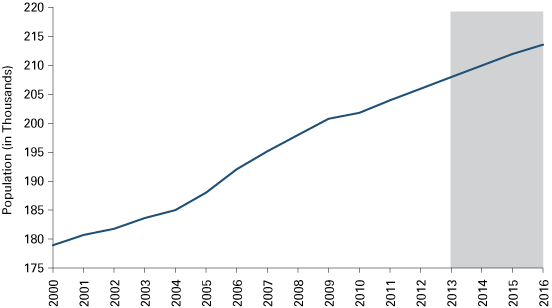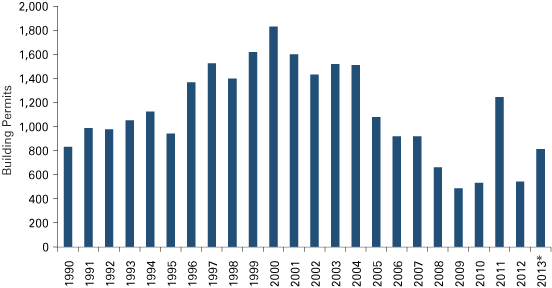Lafayette Forecast 2014
Economic Research Analyst, Indiana Business Research Center, Kelley School of Business, Indiana University
The year 2013 had a series of mixed employment and economic news nationally and statewide, leading to anticipated languid growth rates. The Indiana Business Research Center (IBRC)has long predicted that 2014 may experience a turning point in these trends. On the other hand, the Lafayette Metropolitan Stastistical Area (MSA)—Benton, Carroll and Tippecanoe counties—has had encouraging reports and economic statistics. While the area has not experienced rapid resurgence from the depths of the recession, it has rebounded more quickly than many other areas of the state and maintained steady growth. As we look to the future to determine how 2014 will treat the Lafayette MSA, the area appears poised to continue its growth with announced business expansions, developments and investments in the local economy.
Population
To its benefit, the Lafayette MSA is viewed as an attractive area to live and work, due in part to its proximity to Purdue University. We see this optimism in the continued population growth that is expected for the next few years (see Figure 1). In 2013, the population was estimated to increase 1 percent to 207,946 residents and maintain a 0.9 average annual percent growth each year through 2016. This steady anticipated population growth was consistent with the 2013 forecast and while it is more timid than growth in previous years, it is a step in the right direction.
Figure 1: Annual Population Change in the Lafayette MSA and Tippecanoe County, 2000 to 2016

Source: IBRC, using U.S. Census Bureau data
Labor
Historically, the Lafayette MSA has had a lower unemployment rate than Indiana and the United States. Between August 2012 and August 2013, the Lafayette MSA has outperformed Indiana every month (other than a slight hiccup in July 2013) and stayed closer to the United States’ rate most months (see Table 1). The spread in unemployment rates between the Lafayette MSA compared to the state and nation reflects the improved economy in the MSA. Despite the variability in the labor market (measured by unemployment rates, number of individuals employed, in the labor force and unemployed), the Lafayette MSA is seeing a general trend of individuals finding work.
Table 1: Unemployment Rates in the Lafayette MSA, Indiana and the United States, August 2012 to August 2013
| Year | Month | Lafayette MSA | Indiana | United States |
|---|---|---|---|---|
| 2012 | August | 7.9% | 8.4% | 8.2% |
| September | 6.9% | 7.9% | 7.6% | |
| October | 6.9% | 7.9% | 7.5% | |
| November | 7.4% | 8.1% | 7.4% | |
| December | 7.6% | 8.5% | 7.6% | |
| Annual Average | 7.4% | 8.4% | 8.1% | |
| 2013 | January | 9.2% | 9.6% | 8.5% |
| February | 8.0% | 9.3% | 8.1% | |
| March | 8.2% | 9.1% | 7.6% | |
| April | 6.8% | 8.0% | 7.1% | |
| May | 7.2% | 8.1% | 7.3% | |
| June | 8.6% | 8.7% | 7.8% | |
| July | 8.4% | 8.3% | 7.7% | |
| August* | 6.8% | 7.5% | 7.3% |
*Preliminary data
Source: IBRC, using Bureau of Labor Statistics data
Table 2 looks specifically at the employment picture between 2012 and 2013 in the Lafayette MSA. Last year it was predicted that employment would continue to increase at a slow and steady pace. The manufacturing sector was anticipated to lead this growth followed by the health care and transportation sectors. During 2013, nearly all industries had employment growth and the leading industry has been the professional and business services (adding 400 jobs) followed by manufacturing (adding 375 jobs) and private educational and health services (adding 263 jobs).
Table 2: Lafayette MSA Employment, 2012 to 2013
| Industry | 2013* | Change since 2012 | Percent Change 2012–2013 |
|---|---|---|---|
| Total Nonfarm | 96,900 | 800 | 0.8% |
| Total Private | 70,313 | 1,313 | 1.9% |
| Goods-Producing | 19,300 | 300 | 1.6% |
| Manufacturing | 16,675 | 375 | 2.3% |
| Mining, Logging and Construction | 2,625 | 25 | 1.0% |
| Service-Providing | 77,600 | 500 | 0.6% |
| Professional and Business Services | 8,100 | 400 | 5.2% |
| Private Educational and Health Services | 11,963 | 263 | 2.2% |
| Leisure and Hospitality | 9,225 | 125 | 1.4% |
| Financial Activities | 3,700 | 100 | 2.8% |
| Trade, Transportation and Utilities | 13,938 | 37 | 0.3% |
| Other Services | 3,013 | 13 | 0.4% |
| Information | 1,075 | -25 | -2.3% |
| Government | 26,588 | -512 | -1.9% |
*January through August data annualized for 2013. August data are preliminary.
Source: IBRC, using Bureau of Labor Statistics data
The stronger-than-expected employment growth from professional and business services compared to manufacturing reflects the continuous attraction and expansion of firms associated with research and development within the life sciences and engineering sectors. The close proximity to Purdue University is helping fuel the growing number of start-ups stemming from university research. In total, the Lafayette MSA has 125 high-tech and life science businesses, with many providing services in research, design, consulting and computer programming. While this sector is expanding, many of these businesses have small employment sizes, so it is critical that the Lafayette MSA help nurture these businesses for continued economic development benefits.
Manufacturing will continue to be an important sector in the area and recent announcements indicate this sector is still going strong in the Lafayette MSA. Statewide, manufacturing is expected to pullback on employment, yet several businesses in the Lafayette MSA recently announced expansion plans for equipment, plants and employees (Alcoa, Heartland Automotive, Nanshan, Subaru of Indiana, TKO Graphix and Voestalpine Rotec).
Two sectors—information and government—have seen declining employment in 2013, repeating their 2012 trends. The drop in state and local government jobs at the MSA level reflects cuts made while government officials continue to reallocate budget funds. In 2014, employment growth will likely pick up the pace—moderately—fueled by the professional and business services sector, manufacturing and private health and educational services.
Between the first quarter of 2012 and first quarter of 2013, average weekly wages decreased 0.9 percent within the Lafayette MSA. Eleven out of the 18 major sectors (two were not disclosed) had positive wage increases ranging between 10.8 percent (finance and insurance) and 0.9 percent (other services), as seen in Table 3. The 2013 forecast predicted modest wage increases, which did not occur due to wage declines in management of companies and enterprises (-37.7 percent) and manufacturing (-8.4 percent). Moving into 2014, it is anticipated that the average annual weekly wage will increase slightly, corresponding with the anticipated new jobs in professional and business services, manufacturing and health care services. As the housing market continues to stabilize and improve, wage increases will likely also occur in the construction industries.
Table 3: Average Weekly Wages in the Lafayette MSA, 2013
| Industry | 2013 Q1 | Percent Change since 2012 Q1 | |
|---|---|---|---|
| Average Weekly Wage | Jobs | Average Weekly Wage | |
| Total | $799 | 0.2% | -0.9% |
| Finance and Insurance | $1,044 | 1.1% | 10.8% |
| Administrative Support and Waste Management | $459 | -0.8% | 10.1% |
| Agriculture, Forestry, Fishing and Hunting | $697 | 3.6% | 7.4% |
| Professional, Scientific and Technical Services | $1,052 | 1.1% | 6.7% |
| Educational Services* | $996 | -1.4% | 4.7% |
| Public Administration | $761 | -0.3% | 4.7% |
| Arts, Entertainment and Recreation | $226 | -1.0% | 4.6% |
| Transportation and Warehousing | $799 | -2.0% | 1.8% |
| Health Care and Social Services | $809 | 0.6% | 1.6% |
| Accommodation and Food Services | $260 | -0.9% | 1.6% |
| Other Services (Except Public Administration) | $533 | -0.6% | 0.9% |
| Information | $546 | 1.4% | -1.6% |
| Retail Trade | $434 | 2.3% | -1.8% |
| Wholesale Trade | $946 | 4.2% | -2.0% |
| Construction | $767 | 0.6% | -4.2% |
| Real Estate, Rental and Leasing | $581 | 2.4% | -4.3% |
| Manufacturing* | $1,260 | -0.7% | -8.4% |
| Management of Companies and Enterprises | $1,384 | -1.9% | -37.7% |
*Indicates that some county data was excluded due to confidentiality.
Note: Data for mining and utilities are not shown due to nondisclosure agreements.
Source: IBRC, using QCEW data
The Lafayette MSA’s per capita personal income (PCPI) historically lags the United States due to the occupational mix in the MSA and the fact that Indiana’s highest earning tier of occupations tends to be paid less than similar occupations elsewhere, regardless of cost of living factors. In 2011, the most recent year for which Bureau of Economic (BEA) data are available, the Lafayette MSA’s PCPI was 75.1 percent of the national figure.1 The PCPI increased by 6.4 percent in 2011 and is projected to have grown by 4.6 percent in 2012. PCPI is expected to grow by 3 percent in 2013 and another 4.6 percent in 2014.
Housing
While housing permits issued in 2011 were high, the 2012 number of permits issued fell by 56.4 percent down to 543 permits (see Figure 2). The vast majority of issued permits were for single-family homes (93.7 percent) followed by five or more family home structures (5.9 percent). Of all the MSAs completely within Indiana’s boundaries, the Lafayette MSA had the third largest number of permits issued in 2012. Thus far in 2013, 814 permits have been issued in Tippecanoe County, approximately 50 percent more than the entire MSA’s 2012 permits. The yo-yo trend in housing permits reflects the volatile nature of the housing market, so 2014 will likely see a dip (hopefully slight) in the quantity of permits filed.
Figure 2: Lafayette MSA Residential Building Permits, 1990 to 2013

*Reflects year-to-date figures through August for Tippecanoe County only
Source: IBRC, using U.S. Census Bureau data
Comparing year-to-date (January through September) 2013 figures with 2012 shows that the Lafayette MSA real estate market has stayed about the same with a slight change in listings (2.5 percent), closed sales (11.2 percent) and a decline in months’ supply of inventory (-6.7 percent). Benton County had the largest change in new listings (28.1 percent) whereas Tippecanoe County only had a 1 percent increase since 2012. As of September 2013, the Lafayette MSA had nearly 10 months’ worth of housing inventory to sell (see Table 4). The median sales prices for homes sold varied across counties within the Lafayette MSA. Benton County witnessed an increase in prices for homes sold (26.7 percent) whereas Carroll County had a decline (-11.8 percent) and Tippecanoe County had very little change (1.3 percent). Nationally, housing trends have been positive thus far in 2013, and major changes are not expected in the Lafayette MSA during 2014. Instead, we expect to see a steady return to market stability.
Table 4: Lafayette MSA Year-to-Date Residential Real Estate Sales, 2012 to 2013
| Lafayette MSA | Benton County | Carroll County | Tippecanoe County | |||||||||
|---|---|---|---|---|---|---|---|---|---|---|---|---|
| 2012 | 2013 | Change | 2012 | 2013 | Change | 2012 | 2013 | Change | 2012 | 2013 | Change | |
| New Listings | 2,742 | 2,811 | 2.5% | 89 | 114 | 28.1% | 243 | 263 | 8.2% | 2,410 | 2,434 | 1.0% |
| Closed Sales | 1,645 | 1,829 | 11.2% | 47 | 47 | 0.0% | 112 | 117 | 4.5% | 1,486 | 1,665 | 12.0% |
| Median Sales Price | n/a | n/a | n/a | $45,000 | $57,000 | 26.7% | $101,500 | $89,500 | -11.8% | $128,000 | $129,700 | 1.3% |
| Months Supply of Inventory* | 9.2 | 9.9 | 6.9% | 9 | 11.6 | 28.9% | 12.2 | 12.9 | 5.7% | 6.5 | 5.1 | -21.5% |
| Inventory of Homes for Sale* | 1,190 | 1,110 | -6.7% | 49 | 60 | 22.4% | 153 | 174 | 13.7% | 988 | 876 | -11.3% |
*Data as of September 2013.
Note: Year-to-date reflects January to September data.
Source: IBRC, using Indiana Association of Realtors data
Conclusion
Overall, economic activity in the Lafayette MSA seems to be picking up steam, giving 2014 a more optimistic outlook than in prior years. The anticipated employment growth will trickle down to improvements in PCPI, wages and the housing industry. The Lafayette MSA should continue to cultivate the professional and business services sector as it has had steady growth over the past several years. Statewide, the manufacturing industry is expected to become bearish, but the Lafayette MSA may prove to be an outlier. Indiana’s economic activity is expected to increase in 2014, snapping the state out of its languid growth. The Lafayette MSA will continue to contribute to the state’s economic improvements with lower unemployment rates and better job production fueled by Purdue University’s proximity and the resulting start-up businesses.
Notes
- For more research on differences between the U.S. PCPI and Indiana’s PCPI, see www.ibrc.indiana.edu/ibr/2010/spring/article1.html and www.ibrc.indiana.edu/ibr/2013/spring/article1.html.
Also in this Issue…
- International Outlook for 2014
- U.S. Outlook for 2014
- Financial Outlook for 2014
- Housing Outlook for 2014
- Indiana's Outlook for 2014
- Indiana's Agricultural Outlook for 2014
- Seeking Escape Velocity—Job, Income and Productivity Forecasts
- Anderson Forecast 2014
- Bloomington Forecast 2014
- Columbus Forecast 2014
- Evansville Forecast 2014
- Fort Wayne Forecast 2014
- Gary Forecast 2014
- Indianapolis-Carmel Forecast 2014
- Lafayette Forecast 2014
- Louisville Forecast 2014
- Muncie Forecast 2014
- Richmond Forecast 2014
- South Bend and Elkhart Forecast 2014
- Terre Haute Forecast 2014




